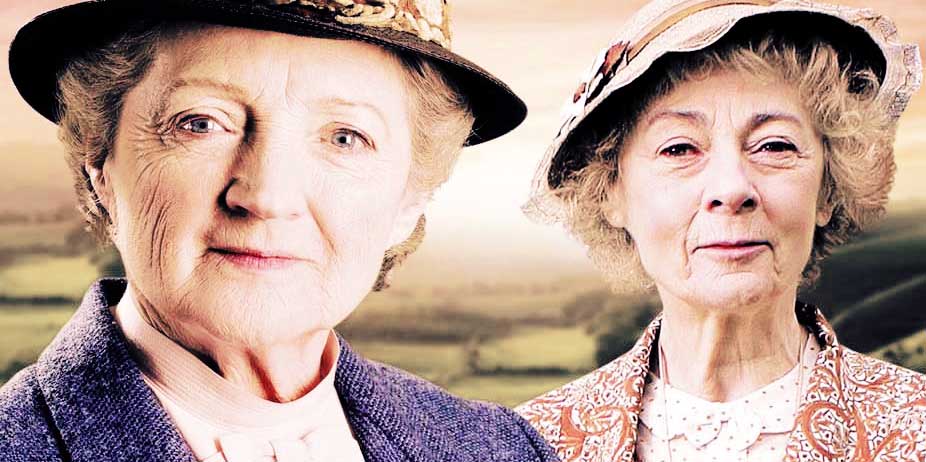 Miss
Marple, Season One (2004)
Miss
Marple, Season One (2004)
Reviewer: Rissi C.
St Merry Mead is a quiet village, a place where gossip flourishes and even the slightest hint of scandal is the source of ladies' conversation at afternoon tea. Colonel Lucius Protheroe (Derek Jacobi) has made a reputation as one of the least liked residents. He thinks himself superior to everyone else, and finds pleasure in putting down the local vicar, Leonard Clement (Tim McInnerny), even going so far as to covertly express the matter in front of the entire congregation. This is something Leonard’s new wife (Rachel Stirling) takes offense at. Much younger than her husband, Griselda Clement is often the topic of conversations… especially when it comes to a struggling artist living in the village. Lawrence Redding (Jason Flemying) has a reputation as quite the ladies’ man and in St. Merry Mead alone he is associated with several of the ladies. Commissioned to paint Colonel Protheroe’s daughter, Lettice (Christina Cole), the Colonel is outraged to discover his daughter is suggestively posing for the portrait while his second wife, Ann (Janet McTeer) attempts to keep peace in the household.
Meanwhile, St. Merry Mead’s most revered resident, known for her sleuthing, Miss Jane Marple (Geraldine McEwan) has a front row seat to all the mysterious happenings when she falls and sprains her ankle. The vicarage garden shed is the place where so many of the goings-on happen, and some of the ladies are appalled at the rumors going on as the answers come out only to question so many more. Finally taking the “risk” and seeing these was a long time coming and even when I did, they were watched backwards. I started with series five before purchasing the recent “collection” release for my mom as a Christmas present. Though these modern adaptations are far from perfect in some terms, they are probably some of the most intelligent scripts I’ve enjoyed in awhile.
The dialogue is sharp and witty, and the mysteries are top-notch. Each are complicated while building the kind of suspense needed in order to be wavering on the edge as to which characters are good and which are not. And I was on the edge of my seat the entire run.
The writers, directors, and cast reveal in their roles just what capable hands this series is in. All four films are intricate and thrilling in their capacity.
Murder at the Vicarage is probably the least impressive in terms of the crime but nevertheless it is still entertaining. For a screenplay to have so many intricate plots, clues and details is not something to make light of.
The Body in the Library is the most ingenious while
4:50 from Paddington (although the end is cute, I will confess, I was rooting for the alternate) is likely my favorite, especially considering it was one of the more favored from an old set.
Although, this is something often associated to these new adaptations, the guest stars are some of the best, most talented Britain has to offer. Derek Jacobi, Christina Cole, Cherie Lunghi, Keeley Hawes, Matthew Goode, and Jack Davenport are only a few of the recognizable names and faces while Julie Cox stars as a young Miss Marple in a heartbreaking flashback. There has been much disagreements and conflict as to which actress depicts Miss Marple the best. Coming from someone unfamiliar with the original contexts, I can say that now I’ve seen three leading ladies in the role, I think Geraldine McEwan takes two sides of a personality and mixes them to give the best portrayal of Miss Marple I’ve seen. Her interpretation of the iconic figure is just enough of the grandmotherly type – having never married nor raised children she wouldn’t be the most natural nurturer, while maintaining a slight sinister characteristic when she lays out the crimes. She totes around her knitting bag, is never seen without a mystery novel and still manages to catch a killer… all while knitting; who says you cannot multi-task and still accomplish things? In spite of all the marvelous attributes and classic material, there are some drawbacks that formulate the middle two mysteries as less than wholesome.
Both incorporate a homosexual plot. The Body in the Library does not dwell on the subject until the final moments where a lesbian relationship is revealed (including a same-sex kiss and proclamations of undying love). The second is a tad more prevalent as a lesbian couple obviously live together; the “male” half is disturbed to have a guest in the house – the two hold hands, share affectionate glances and one kiss. Other mild insinuations may be woven into the dialogue. Illegitimate children are mentioned as are adulterous affairs, some of which are motive for murder. The first of the set sees a brief tryst between a married woman and her lover when they are caught (they are against a wall; his shirt is undone and his hand is up her skirts).
Other than those instances, any other concerns are the crimes. Victims are poisoned, others are bludgeoned to death, and another is shot. None of the crimes are graphically filmed and if any, the worst of the language are some uses of b******d and b*tch. Even as unpleasant as the homosexual themes are – really the only determent of the series, I appreciate it not being as the focal point nor more graphic than it was. Had I not already known, I do not think I’d have ever guessed that
The Body in the Library would end as it did.
The filmmakers more than make up where they fail conservative viewers,
with rich sets and costumes. The countryside scenery is breathtaking and the camera angles and editing was crafted well. In terms of filming, if one thing does become a bit “old” it’s the use of so many flashbacks. They are frequent most especially in the opening and in what follows but that does seem to settle down to some extent so that it isn’t quite the distraction it once was; they all are eight, ten, fifteen years later so that the foundation of the tale is more important than it may have seemed. No matter your motivation for seeing these – cast, genre, era,
etc, one thing you can be assured of is an entertaining evening of fun while you try and solve a jolly good murder with the delightful antics of St. Merry Mead’s most famous resident.
